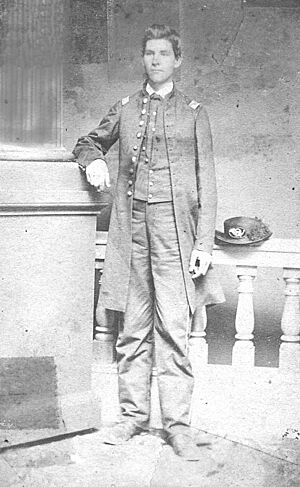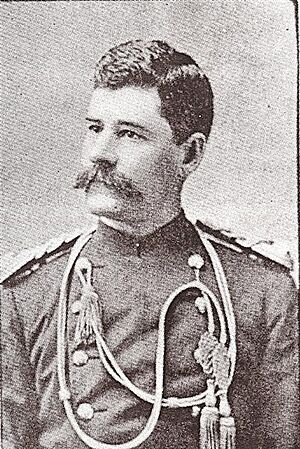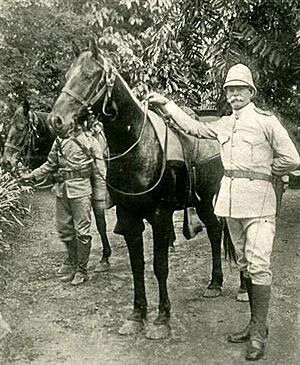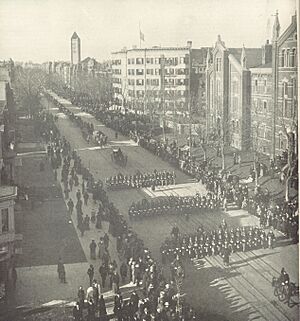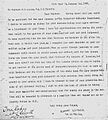Henry Ware Lawton facts for kids
Quick facts for kids
Henry Ware Lawton
|
|
|---|---|
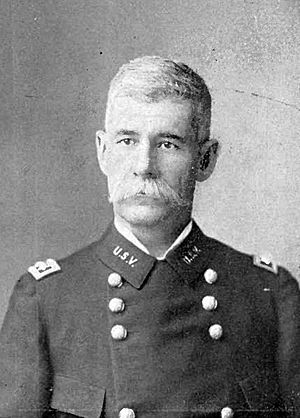
Major-General Henry Ware Lawton, Meserve Collection
|
|
| Born | March 17, 1843 Maumee, Ohio, U.S. |
| Died | December 19, 1899 (aged 56) San Mateo, Manila, Philippine Islands |
| Place of burial |
initially Paco Cemetery in Manila,
then Arlington National Cemetery |
| Allegiance | |
| Service/ |
|
| Years of service | 1861–1865, 1866–1899 |
| Rank | |
| Unit | |
| Battles/wars | American Civil War
|
| Awards | Medal of Honor |
| Signature | |
Henry Ware Lawton (born March 17, 1843 – died December 19, 1899) was a brave U.S. Army officer. He served with great courage in several important wars. These included the American Civil War, the Apache Wars, and the Spanish–American War. He even received the Medal of Honor for his heroic actions during the Civil War.
Lawton was the only U.S. general officer to be killed during the Philippine–American War. He was also the first U.S. general killed in a battle overseas. The city of Lawton, Oklahoma, is named after him. A part of Havana, Cuba, also carries his name. In Manila, a square called Liwasang Bonifacio was once known as Plaza Lawton to honor him.
Contents
Early Life and Schooling
Henry Ware Lawton was born in Maumee, Ohio, on March 17, 1843. His father, George W. Lawton, was a millwright. In 1843, his family moved to Fort Wayne, Indiana. Henry lived with relatives for some time after his mother passed away in 1854.
He attended public school in Florence Township, Ohio. Later, he traveled with his father to Iowa and Missouri. In 1858, he returned to Fort Wayne. He then enrolled at the Methodist Episcopal College. He was studying there when the American Civil War began.
Serving in the Civil War
Lawton was one of the first to join the army when President Abraham Lincoln asked for volunteers. He signed up on April 24, 1861. He was a sergeant in the 9th Indiana Volunteers. He fought in battles like Philippi and Battle of Corrick's Ford.
After his first service ended, Lawton joined the 30th Regiment Indiana Infantry. He quickly became a first lieutenant. His unit joined the Army of the Ohio. They fought in the very bloody Battle of Shiloh. His unit also fought in the Siege of Corinth in Mississippi.
At just 19 years old, he was promoted to captain in May 1862. He fought in over 22 major battles. These included Stones River and Chickamauga. Years later, he received the Medal of Honor for his bravery during the Atlanta Campaign. By the end of the war, he was a brevet (temporary) colonel.
Fighting in the Indian Wars
After the Civil War, Lawton went to Harvard Law School. He graduated in 1866 and then returned to the army. He wanted to be a captain, but instead became a second lieutenant. Generals William Tecumseh Sherman and Philip Sheridan supported his return to service.
Lawton joined the 41st Infantry Regiment. He served under Colonel Ranald S. Mackenzie for many years. He became known as a tough and determined fighter. He also earned a reputation for being a very organized quartermaster (someone who handles supplies). Lawton fought in many major Indian campaigns in the southwest. This included the Battle of Palo Duro Canyon.
Lawton was also known for his kindness towards Native Americans. He even spoke up for them when their food supplies were cut short.
In 1886, Lawton was a captain in the 4th Cavalry. General Nelson A. Miles chose him to lead the mission to capture Geronimo. Geronimo was a famous Apache leader. Lawton's job was to pursue Geronimo and his followers. He had to bring them back to the U.S., whether dead or alive.
Lawton's team pursued Geronimo constantly. They wore the Apache group down. Geronimo and his small band had little time to rest. Finally, they were exhausted. They returned to the U.S. with Lawton. Geronimo officially surrendered to General Miles on September 4, 1886. Geronimo himself said Lawton's constant pursuit made them give up.
After this, Lawton was promoted to major in 1888. Then, in 1889, he became a lieutenant colonel. He worked to improve the army's organization and equipment.
The Spanish–American War
In May 1898, Lawton became a brigadier general of volunteers. He led the 2nd Division of the Fifth Army Corps. His unit was sent to Cuba. They led the invasion of Cuba at Daiquirí. This was a beach area east of Santiago. American forces landed there on June 22, 1898.
Lawton's 6,000 troops moved inland as Spanish forces retreated. They reached Siboney on June 23. General Joseph Wheeler's unit got into a fierce fight at the Battle of Las Guasimas. Lawton's troops rushed to help, but the battle was over when they arrived. The easy retreat of the Spanish made Americans think they would be easy to defeat. This led to some mistakes in planning later battles.
Lawton's division was sent to capture the Spanish fort at El Caney. The American forces faced heavy fighting. Lawton's division suffered many losses. But they eventually took the city. They then joined other U.S. forces at San Juan Hill for the Siege of Santiago. After Santiago fell, Lawton became the military governor of Santiago de Cuba province. He held this position from August to October 1898.
Lawton faced many challenges. He had to deal with the health of American troops. He also had to improve sanitation in Santiago. Many residents were sick and needed help. He worked to restore order in the city. He replaced Spanish police officers with Cubans. He also helped re-establish trade and commerce. Lawton was known for being very involved. He worked alongside his troops every day.
Lawton suffered from a fever, possibly malaria, during this time. This illness forced him to take a medical leave in October 1898. He returned to the U.S. and prepared for his next assignment.
The Philippine–American War
After the war with Spain, Lawton was sent to the Philippines. He commanded the 1st Division of the Eighth Army Corps. This was during the Philippine–American War. He played a big part in early victories. These included battles at Santa Cruz and Zapote Bridge. He was able to inspire his troops. He used tactics he learned from fighting in the American West.
Lawton was very popular with his men and the public. His image even appeared on Filipino money in the 1920s. A major plaza in Manila was named Lawton Plaza. It was later renamed Liwasang Bonifacio in 1963. President William McKinley praised Lawton for his successful operations.
General Emilio Aguinaldo, the first President of the Philippines, called Lawton "The General of the Night." Aguinaldo said this because Lawton often attacked at night. He never knew when Lawton would come.
During the Battle of Paye, Lawton was in the middle of the fighting. He was killed by a Filipino sharpshooter. This sharpshooter was under the command of a general named Licerio Gerónimo. Lawton was the highest-ranking American officer killed in either the Spanish-American or Philippine-American Wars. His promotion to brigadier general in the Regular Army was being processed on the day he died.
Lawton's body was first laid to rest at Paco Cemetery in Manila. His body left the Philippines on December 30, 1899. He was buried at Arlington National Cemetery on February 3, 1900.
Honors and Memorials
Nine years after his death, a statue of Henry W. Lawton was placed in Indianapolis. The statue was created in 1906. It won an award at the Paris Salon competition. This was the first time an American entry won this prize. President Theodore Roosevelt and Vice President Charles W. Fairbanks attended the dedication. A famous poet, James Whitcomb Riley, wrote a poem for the event. In 1917, the statue was moved to Garfield Park.


In Manila, the plaza in front of the Manila Central Post Office was named "Plaza Lawton." It was renamed Liwasang Bonifacio in 1963. Today, the name Lawton still refers to the area around the post office. Also, the main road leading to the Manila American Cemetery is called Lawton Avenue.
In 1899, the Army named a fort after Lawton. Fort Lawton was located near Seattle. It became a very important port for sending soldiers and supplies during World War II. The fort closed in 1971. Most of its land is now Discovery Park.
The Lawton Glacier in Alaska was also named for him in 1899. Later, its spelling was changed to Laughton Glacier. The city of Lawton, Oklahoma, and Lawton Street in San Francisco are also named after him.
Henry Ware Lawton was played by actor John S. Davies in the 1997 miniseries Rough Riders.
Awards and Medals
- Medal of Honor
- Civil War Campaign Medal
- Indian Campaign Medal
- Spanish Campaign Medal
- Army of Cuban Occupation Medal
- Philippine Campaign Medal
Note: Most of these awards were created after General Lawton's death. Only the Medal of Honor was awarded during his lifetime.
See also
- List of Medal of Honor recipients
- List of American Civil War Medal of Honor recipients: G–L
- Young's Scouts
Images for kids
-
Band of Apache Indian prisoners at rest stop beside Southern Pacific Railway, near Nueces River, Tex. (Geronimo is third from the right, in front), September 10, 1886.


